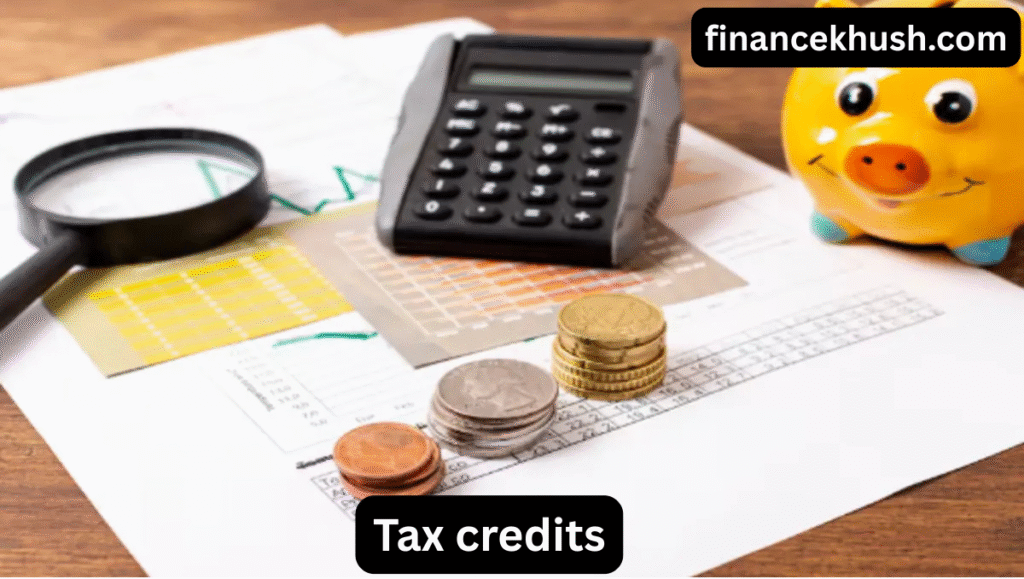Tax credits can be a game-changer when it comes to reducing your tax liability. Whether you’re an individual taxpayer, a small business owner, or a large corporation, tax credits can help you save money by reducing the amount of taxes you owe to the government. However, just like any financial tool, there are both positives and negatives to tax credits. In this guide, we’ll explore what tax credits are, how they work, the different types available, and the pros and cons of using them.
What Are Tax Credits?
In simple terms, a tax credit is a benefit that allows taxpayers to subtract a certain amount from the total taxes they owe. Unlike deductions, which reduce your taxable income, tax credits directly reduce the amount of tax you owe. For example, if you owe $1,000 in taxes and you have a $200 tax credit, you only need to pay $800.
1: Nonrefundable Tax Credit: If your tax liability is less than your credit, you lose the excess. For example, if you owe $100 in taxes and you have a $200 nonrefundable credit, you will only reduce your tax liability to $0. The remaining $100 goes unused.
2: Refundable Tax Credit: If your tax liability is less than your credit, the government will refund the excess. For instance, if you owe $100 and have a $200 refundable credit, you would reduce your tax liability to $0 and receive a refund of $100.
Types of Tax Credits
Now that we understand the basic definition of tax credits, let’s look at some common examples.
1. Earned Income Tax Credit (EITC)
This credit is available to low- and moderate-income earners. The amount of the credit depends on your income, filing status, and number of children. The EITC is a refundable tax credit, meaning that if you qualify, it could result in a refund even if you don’t owe taxes.
2. Child Tax Credit (CTC)
This is one of the most popular tax credits for families. The Child Tax Credit allows taxpayers to claim a credit for each child under the age of 17. For 2023, the credit can be worth up to $2,000 per child, with up to $1,500 being refundable.
3. Education Tax Credits
There are two main education-related tax credits:
1: American Opportunity Tax Credit (AOTC): This credit helps students pay for their first four years of post-secondary education. It can be worth up to $2,500 per eligible student per year and is partially refundable.
2: Lifetime Learning Credit (LLC): This credit helps with the cost of education beyond the first four years. It offers up to $2,000 per year for qualifying tuition and related expenses.
4. Energy Tax Credits
The government offers tax credits to encourage the use of renewable energy sources. If you install solar panels, energy-efficient windows, or a geothermal heat pump, you may qualify for these credits. These credits can help reduce the cost of these installations.
The Positives of Tax Credits
Now that you understand what tax credits are and some of the common types, let’s talk about why they can be so beneficial. There are several positive aspects to tax credits that make them an attractive financial tool.
1. Reduce Your Tax Liability Directly
The most significant benefit of tax credits is that they directly reduce the amount of tax you owe. This means more money in your pocket. Unlike tax deductions, which only reduce your taxable income, tax credits have a direct impact on your tax bill.
2. Refundable Credits Can Provide Extra Money
Refundable tax credits are particularly valuable because they can result in a refund even if you don’t owe any taxes. For example, if you qualify for the Earned Income Tax Credit (EITC), you could end up receiving a check from the IRS, even if your tax liability is $0. This is a great way to put some extra cash in your hands.
3. Encourage Certain Behaviors
Tax credits often incentivize specific behaviors, such as education or renewable energy adoption. For example, the Education Tax Credits help make higher education more affordable, and Energy Tax Credits promote sustainability by encouraging the use of clean energy.
4. Support for Low-Income Households
Many tax credits, such as the EITC and Child Tax Credit, are designed to help low- and moderate-income families. These credits can provide significant financial relief, helping to reduce poverty and improve quality of life.
5. You Don’t Have to Be a Tax Expert
Claiming a tax credit is relatively straightforward. Most credits simply require you to meet specific eligibility requirements, like having children or making energy-efficient home improvements. As long as you provide the necessary documentation, claiming tax credits is generally an easy process.

The Negatives of Tax Credits
While tax credits offer many benefits, they aren’t without their downsides. It’s important to be aware of the potential challenges that come with using them.
1. Eligibility Requirements Can Be Complex
One of the main drawbacks of tax credits is that they often come with complicated eligibility requirements. For example, in order to qualify for the Child Tax Credit, your income must fall within specific thresholds, and you must meet other criteria as well. If you don’t meet these requirements, you won’t be able to claim the credit.
2. Nonrefundable Credits Don’t Provide Cash Back
If you qualify for a nonrefundable tax credit and your tax liability is lower than the credit amount, you won’t receive any excess back. This can be disappointing if you were hoping to get money back from the government.
3. Potential for Tax Audits
Claiming tax credits, especially the ones with more complex rules, can increase your chances of being audited by the IRS. If you make a mistake or fail to properly document your eligibility for a tax credit, you could end up facing penalties or being required to pay back the credit.
4. The Credits Can Change Annually
Tax credits are subject to change from year to year. Some credits may be expanded, reduced, or even eliminated, depending on changes in tax laws and government priorities. This means that tax credits you relied on in one year may not be available in the next.
5. Limited to Specific Expenses or Groups
Many tax credits are targeted at specific expenses or groups of people. For example, you can only claim the Energy Tax Credit if you install eligible energy-efficient systems in your home, or you can only claim the Education Credits if you’re enrolled in a qualified educational institution. If your situation doesn’t match these criteria, you won’t be able to take advantage of these credits.
Tips for Claiming Tax Credits
To make sure you get the most out of tax credits, here are a few tips:
1. Keep Good Records
Make sure to keep all relevant documentation, such as receipts, tax forms, and proof of income. This will help you when it comes time to file your taxes and claim credits.
2. Consult a Tax Professional
Tax credits can be complex, and there may be additional credits you’re eligible for that you didn’t know about. A tax professional can help you navigate the system and maximize your savings.
3. Stay Updated
Tax laws change frequently, and credits that were available one year may not be available the next. Be sure to check for any updates to the credits you are eligible for each year.
4. Understand the Fine Print
Make sure you understand the full eligibility requirements and limitations of any credit you’re claiming. Sometimes, a seemingly straightforward credit can have tricky rules that could cause you to lose out on the benefit.

Conclusion
In conclusion, tax credits are a powerful tool that can help reduce your tax liability, increase your refund, and encourage certain positive behaviors. They are especially beneficial for low- and moderate-income earners, families with children, students, and those making environmentally conscious decisions.
However, it’s important to be aware of the complexities surrounding tax credits. Eligibility requirements can be tricky, and claiming the wrong credit or failing to meet the criteria can result in penalties or lost benefits. Refundable credits offer the best opportunity for those looking for cash-back options, but nonrefundable credits can still provide a significant benefit for those with high enough tax liabilities.
Related post
Here are top 6 best faq’s
1. What is a tax credit?
A tax credit is an amount you can subtract directly from the taxes you owe. Unlike tax deductions (which reduce your taxable income), tax credits reduce the amount of tax you need to pay. For example, if you owe $1,000 in taxes and have a $200 tax credit, you’ll only need to pay $800.
2. What’s the difference between refundable and nonrefundable tax credits?
- Refundable tax credits: If your credit is more than your tax bill, you’ll get the extra amount as a refund from the government.
Example: If you owe $100 in taxes but have a $200 refundable credit, you get $100 back. - Nonrefundable tax credits: If your credit is more than your tax bill, you lose the extra amount.
Example: If you owe $100 in taxes but have a $200 nonrefundable credit, you only reduce your tax bill to $0. You lose the extra $100.
3. How do I qualify for tax credits?
To qualify for a tax credit, you must meet certain eligibility requirements. These can include factors like your income, filing status, number of dependents, or specific expenses you’ve had (like education or energy-efficient home improvements). The rules depend on the type of credit you’re applying for, so it’s important to check each credit’s specific qualifications.
4. Can I claim multiple tax credits in one year?
Yes! You can claim multiple tax credits in the same year if you meet the eligibility requirements for each one. For example, you could claim the Child Tax Credit for your kids, the Earned Income Tax Credit (EITC) for lower-income workers, and any education credits if you’re taking classes. Just make sure you meet the criteria for each one!
5. Can I get money back from tax credits?
Yes, if you qualify for a refundable tax credit, you can get money back, even if you don’t owe taxes. For example, the Earned Income Tax Credit (EITC) can give you a refund if you meet the requirements. However, nonrefundable credits will only reduce the amount of taxes you owe, not give you cash back.
6. What happens if I claim a tax credit I’m not eligible for?
If you claim a tax credit you’re not eligible for, the IRS may ask you to pay back the credit. In some cases, they might even charge you a penalty. It’s important to carefully check if you meet the requirements before claiming any tax credit. If you’re unsure, it’s a good idea to consult with a tax professional.

1 thought on “How Tax Credits Can Lower Your Tax Bill In 2025”